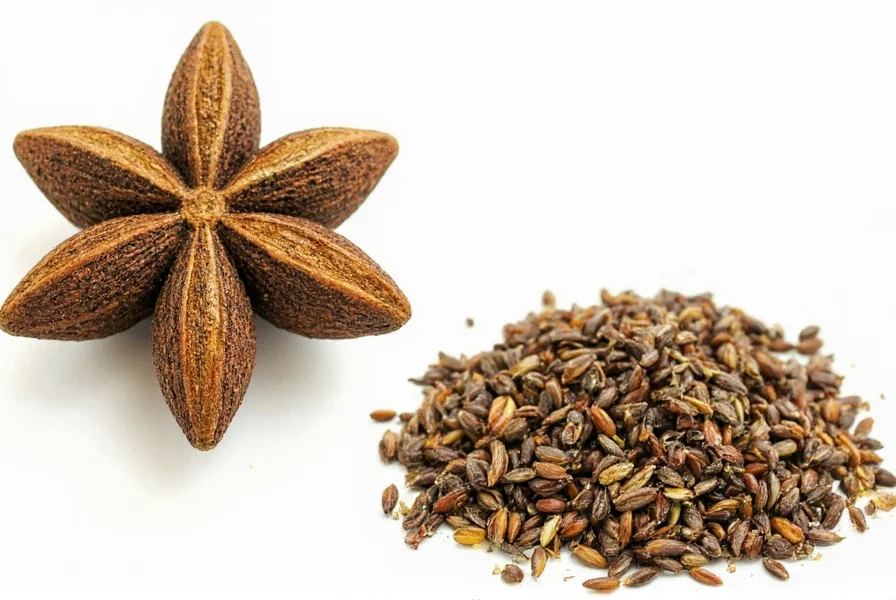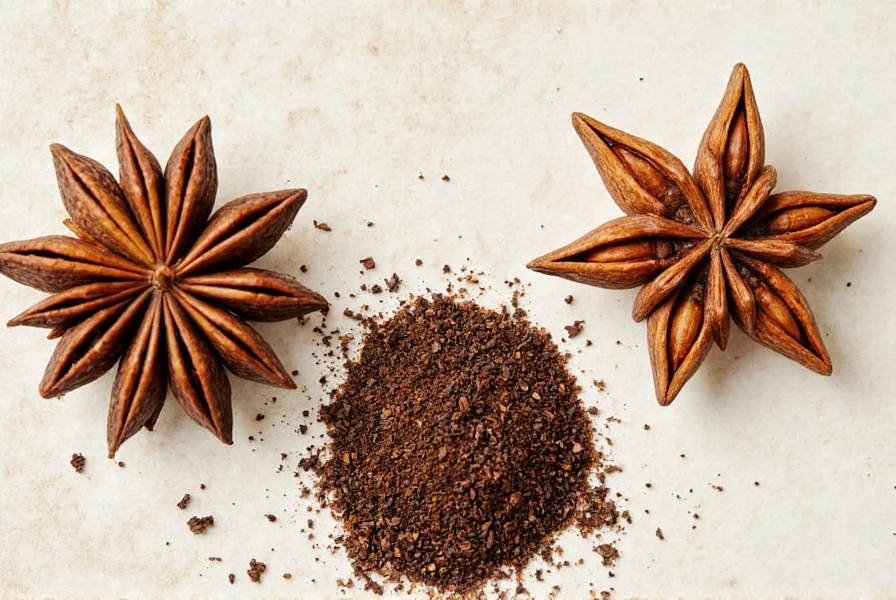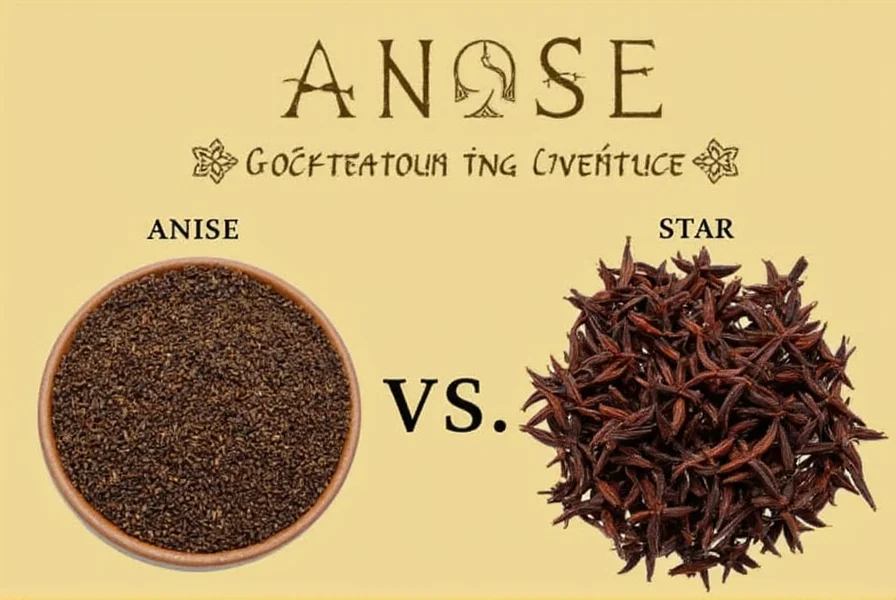Anise and star anise are completely different plants with distinct botanical origins, though both deliver a licorice-like flavor. True anise (Pimpinella anisum) is a flowering plant in the celery family whose small, oval seeds provide a sweet, delicate licorice taste. Star anise (Illicium verum) is the star-shaped fruit pod of a small evergreen tree in the magnolia family, offering a stronger, more intense licorice flavor with subtle woody notes. Understanding the difference between anise and star anise is essential for proper culinary application.
When exploring the world of aromatic spices, few comparisons cause as much confusion as anise vs star anise. Despite their similar flavor profiles and frequent substitution in recipes, these two ingredients come from entirely different botanical families and offer unique culinary properties. This comprehensive guide clarifies the critical distinctions that every home cook and professional chef should know.
Botanical Origins: Understanding the Fundamental Difference
The most essential fact to grasp about anise and star anise is that they're not closely related plants. True anise (Pimpinella anisum) belongs to the Apiaceae family (the same family as carrots, celery, and parsley). It's an annual herb that produces small, grayish-brown, oval seeds about 3-5mm long. These seeds contain 2-7% essential oil, primarily composed of anethole, which creates the characteristic licorice flavor.
Star anise (Illicium verum), by contrast, comes from the Schisandraceae family. It's the fruit of a small evergreen tree native to西南 China and Vietnam. The fruit forms in a distinctive star shape with 6-8 pointed pods, each containing a single seed. Star anise contains 80-90% anethole, explaining its more intense licorice flavor compared to regular anise.
| Characteristic | Anise (Pimpinella anisum) | Star Anise (Illicium verum) |
|---|---|---|
| Botanical Family | Apiaceae (carrot family) | Schisandraceae |
| Plant Type | Annual herb | Evergreen tree |
| Part Used | Small oval seeds | Star-shaped fruit pods |
| Anethole Content | 2-7% | 80-90% |
| Flavor Intensity | Milder, sweeter | Stronger, more intense |
| Primary Culinary Regions | Mediterranean, Middle Eastern | Asian cuisines |
Physical Characteristics and Identification
Visually distinguishing anise from star anise is straightforward. Anise seeds are small (3-5mm), grayish-brown, oval-shaped seeds that resemble fennel seeds but are slightly smaller and more curved. They have a smooth texture and a single ridge running down the length.
Star anise earns its name from its distinctive appearance—a rust-colored, star-shaped pod typically with 6-8 points. Each point contains a single seed. The entire pod is used in cooking, though sometimes the seeds are removed and ground separately. The pods measure approximately 2.5-4cm across.

Flavor Profile Comparison
While both spices share the characteristic licorice flavor due to anethole, their flavor profiles differ significantly:
Anise seeds deliver a sweeter, milder licorice flavor with subtle floral notes. The taste is more delicate and integrates smoothly into dishes without overwhelming other flavors. This makes anise ideal for baked goods, light sauces, and delicate desserts where a pronounced licorice note isn't desired.
Star anise provides a much more intense licorice flavor with additional woody, earthy undertones. Its potency means a little goes a long way—using too much can easily dominate a dish. Star anise works best in robust preparations like braises, stews, and spice blends where its strong flavor can mellow and integrate during long cooking times.
Culinary Applications and Regional Usage
The difference between anise and star anise extends to their traditional culinary applications across global cuisines:
Anise seed features prominently in Mediterranean and Middle Eastern cooking. It's essential in Greek ouzo, Turkish raki, and French pastis. In baking, anise seeds flavor biscotti, pizzelles, and German springerle cookies. The seeds also enhance fruit compotes, roasted vegetables, and fish dishes.
Star anise is a cornerstone of Asian cuisine, particularly in Chinese, Vietnamese, and Indian cooking. It's one of the five spices in Chinese five spice powder and essential in Vietnamese pho broth. Star anise features in Indian garam masala, adds depth to Chinese red cooking braises, and flavors chai tea blends. Its robust nature makes it ideal for slow-cooked dishes where it can infuse flavor throughout the cooking process.
Substitution Guidelines: When and How to Swap
Understanding anise seed vs star anise pod substitution is crucial for successful cooking. While they can sometimes replace each other, the conversion isn't 1:1 due to their different flavor intensities.
When substituting star anise for anise seed, use approximately 1 whole star anise pod for every 1 teaspoon of anise seeds. For ground substitutions, use 1/4 teaspoon ground star anise for every 1 teaspoon of ground anise seed. Always remember that star anise's flavor intensifies with longer cooking times.
When substituting anise seed for star anise, you'll need more to achieve similar flavor intensity—typically 1.5-2 times the amount of anise seed compared to star anise called for in the recipe. This substitution works better in quick-cooking dishes since anise seed's milder flavor won't develop the same depth as star anise in long braises.
Chef's tip: For the most authentic results, follow regional recipes using their traditional spice. Mediterranean recipes typically specify anise seed, while Asian recipes call for star anise. Substitutions often alter the dish's authentic character.
Storage and Shelf Life Considerations
Proper storage affects both spices' flavor longevity. Whole anise seeds maintain their flavor for 2-3 years when stored in an airtight container away from light and heat. Ground anise loses potency more quickly, typically within 6-12 months.
Whole star anise pods retain their intense flavor for 3-4 years under proper storage conditions. The pods' structure helps preserve the essential oils better than loose seeds. Ground star anise degrades faster, with optimal flavor lasting 1-2 years.
Always check for freshness by smelling the spice—fresh anise should have a sweet, fragrant aroma, while fresh star anise delivers a powerful licorice scent. Stale spices lose their characteristic fragrance and flavor intensity.
Common Misconceptions Clarified
Several misconceptions surround anise and star anise that deserve clarification:
Misconception: Star anise is just a larger version of anise seed.
Reality: They come from completely different plant families with distinct botanical classifications.
Misconception: Japanese star anise is a safe alternative to Chinese star anise.
Reality: Japanese star anise (Illicium anisatum) is highly toxic and should never be consumed. Always purchase star anise from reputable sources to avoid this dangerous confusion.
Misconception: Anise and fennel seeds are the same.
Reality: While related (both in Apiaceae family), fennel has a milder, sweeter flavor profile without the pronounced licorice note of anise.
Practical Tips for Cooking with Anise and Star Anise
Maximize flavor from these spices with these professional techniques:
- Toasting anise seeds: Dry toast in a skillet over medium heat for 1-2 minutes until fragrant. This enhances their sweet, delicate flavor without becoming bitter.
- Using whole star anise: Add early in cooking for braises and soups to allow full flavor extraction. Remove before serving as the hard pods are unpleasant to bite into.
- Grinding techniques: Use a dedicated spice grinder for star anise as its oils can linger and affect other spices. Anise seeds grind more easily in standard spice mills.
- Infusing liquids: Steep whole star anise in simmering broths or syrups for 15-20 minutes. For anise seed infusions, 5-10 minutes typically suffices due to their milder flavor.

When Substitution Works (and When It Doesn't)
While understanding the difference between anise and star anise helps with substitutions, certain applications demand the specific spice:
Successful substitutions:
- Using ground anise seed in place of ground star anise in baked goods (adjusting quantity)
- Substituting star anise in spice blends where other strong flavors balance its intensity
- Using either in liqueur production where long infusion times mellow differences
Poor substitutions:
- Replacing star anise in traditional pho broth (changes authentic flavor profile)
- Using star anise in delicate pastries where its strong flavor overwhelms
- Substituting anise seed in Chinese five spice powder (alters the blend's character)
When experimenting with anise seed substitution ratios, always start with less than you think you need—you can add more during cooking, but you can't remove excess spice once added.











 浙公网安备
33010002000092号
浙公网安备
33010002000092号 浙B2-20120091-4
浙B2-20120091-4